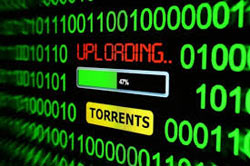 The word torrenting is often viewed as synonymous with pirating. It’s seen as a shady and illegal practice, used to con hard working artists out of their money. As a result, internet service providers often blanket ban torrent websites or severely throttle downloads. If you aren’t using a VPN for torrenting, there’s a good chance you’re affected by this. However, ISPs over-arching policies can hurt users that use Peer-to-Peer (P2P) file sharing for innocent purposes.
The word torrenting is often viewed as synonymous with pirating. It’s seen as a shady and illegal practice, used to con hard working artists out of their money. As a result, internet service providers often blanket ban torrent websites or severely throttle downloads. If you aren’t using a VPN for torrenting, there’s a good chance you’re affected by this. However, ISPs over-arching policies can hurt users that use Peer-to-Peer (P2P) file sharing for innocent purposes.
How Torrenting & Peer-to-Peer (P2P) Works
Instead of using dedicated servers, P2P utilizes the connections of other users to distribute files. As they download a torrent, the individual also uploads a small portion for others to download. This creates an interconnected network where files are provided by many different people.
One huge example of legal P2P usage is gaming. Online games such as World of Warcraft, League of Legends, and downloads from UPlay all have a P2P option. This saves on server costs for the developers and can increase torrent speed. This can foster development for smaller, indie companies, who might not have the infrastructure for lots of servers.
In fact, Windows 10 even takes advantage of this method to save on bandwidth issues. The OS delivers updates in multiple parts, pulling bits from both PCs on the same network, over the internet, and Microsoft’s own data centers. This feature is turned on by default since the Windows 10 Anniversary Update in the summer of 2016.
However, more important is the role of torrenting in distributing public data. The Internet Archive caches huge amounts of websites and offers a huge variety of public domain books, TV shows, and audio recordings. The non-profit recommends the use of torrents to download its content, as it saves on bandwidth and allows it to continue its vital work.
This role extends even to government. NASA has used torrents several times in the past to distribute its findings, including this high-resolution picture of earth. The UK government has done similarly, releasing large datasets on public spending via BitTorrent.
As well as supporting government, BitTorrent is also used to oppose it. Transparency sites such as Julian Assange’s Wikileaks often release so-called ‘insurance files’ through torrents. Shortly before the leak of Hilary Clinton’s emails, the site published an 88GB, 256-AES encrypted file. This keeps the organization from being shut down – if WikiLeaks goes dark, an automated message sends out an unlock password for all the data. In previous cases, files have reached upwards of 400GB.
Despite the genuine uses of P2P, users still get attacked by copyright claimants, sometimes inaccurately. In 2015, the creators of B-movie Elf Man filed a lawsuit against hundreds of users who claimed to have never even heard of the movie. Ryan Lamberson was one of these defendants and was eventually reimbursed for $100,000 in legal fees. Closer examination of evidence revealed that the tools used by the copyright holder did not account for several shortcomings, and only tracked uploads rather than downloads.
The defense also pointed out that the primary evidence was little more than an IP address. This information came from a third-party software that connected to the BitTorrent swarm in which the files were shared. However, some torrent software allows for the spoofing of IP addresses, and the investigator failed to account for several other false positives. Because of the win, several other Elf Man cases were dropped or settled for a lower value.
Other thrown cases include the Adam Sandler movie The Cobbler, and a 53-year-old artist painter was wrongly accused of illegally downloading and sharing 18 films and TV shows. Thankfully, there is a simple way to avoid such risks.
Anonymous Torrenting with a VPN Service
Using a VPN for torrenting will ensure your identity remains private, not just from ISPs, but copyright claimants and government. When you connect to a VPN, all your traffic goes through a “tunnel”. The individual packets that make up your data contain information such as IP Address, protocol, and other identifying information.
Tunneling wraps those packets in others that provide extra security against prying eyes. In addition, the data is encrypted in transit, meaning ISPs, service providers and other middlemen see nothing but gibberish. Different providers use different encryption methods, the most common being IPSec, L2TP, and OpenVPN.
The benefit of this tunneling is clear. An ISP or copyright holder can only see the IP address of the VPN servers, not your own. This makes for anonymous torrenting, and they can’t see what website’s you’ve visited either. Though this might not protect you against entirely baseless accusations, it should stop you from coming under genuine suspicion.
A VPN for torrenting will also provide you with protection in other ways. To stay safe on public WiFi, they are almost essential. Without one, attackers can snoop on your online traffic, possibly recovering passwords and credit card details. You could also be vulnerable to malware on your machine and tracking from third parties.
However, not all VPNs are created equal. Though some provide anonymous torrenting and public WiFi protection, others are questionable at best. Researching hundreds of different providers can be a pain, so instead we’ve done that for you. Our network security team has produced a VPN service review of all the Best VPN Service Providers, alongside detailed feature lists.
Avoid ISP Bandwidth Throttling
 Encrypted communication has the add-on effect of avoiding bandwidth throttling from ISPs. As mentioned earlier, service providers inspect packets to classify different data. This lets them put a speed cap on specific mediums. This is usually done unofficially and some service providers will deny the practice despite significant data to the contrary.
Encrypted communication has the add-on effect of avoiding bandwidth throttling from ISPs. As mentioned earlier, service providers inspect packets to classify different data. This lets them put a speed cap on specific mediums. This is usually done unofficially and some service providers will deny the practice despite significant data to the contrary.
Despite this, it’s becoming more and more routine for ISPs to throttle or block torrent downloads. Everything you receive goes through their servers, allowing them to analyse it with Deep Packet Inspection. This method lets the service provider look at different data packets and classify it into different categories, such as video, music, and torrents.
Bandwidth throttling can be achieved in several ways. One method is blocking router ports often used for BitTorrent. Typically, P2P downloads go through TCP ports from 6881-6889. By limiting the speed on these, an ISP can cut out a big chunk of bandwidth.
However, this method is becoming less and less popular. Increasingly, torrent clients randomize TCP ports or tell users if there are any issues. As a result, internet service providers use methods that are harder to dodge.
One such technique is called traffic shaping. The flow of certain packets is delayed in favour of others, affecting download and upload speed. This can be done as a blanket, or through intelligent burst shaping. Burst shaping increases torrent speeds for a short period, before gradually returning to a lesser speed. Thus, extended downloads such as movies, games, and streaming are slower, while web pages still load quickly.
The need for shaping comes from the limited bandwidth resources of an ISP. It lets the service provider guarantee performance to other users by reducing the effect of heavy users. Often, P2P is main target for this, and it’s easy to see why. Torrent downloads use large amounts of bandwidth and therefore cost a lot of money to sustain. In addition, companies are under a lot of legal pressure from copyright holders. By throttling, they can assure the parties that they’re doing their bit to limit the impact of pirates.
Unfortunately, it’s difficult to differentiate between legal P2P downloads and illegal ones. This means that regular users can be throttled due to blanket policies. You can check if your torrents are being throttled by running the Glasnost test. The eight-minute download will detect bandwidth throttling in the upload and download streams separately.